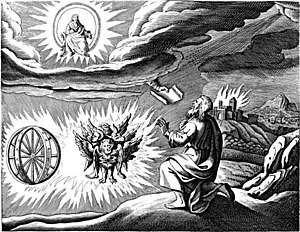Ophanim
The ophanim or ofanim (Heb. "wheels" אוֹפַנִּים ’ōphannīm; singular: אוֹפָן ’ōphān, ofan), also called galgalim (galgallim, גַּלְגַּלִּים - "spheres", "wheels", "whirlwinds"; singular: galgal, גַּלְגַּל), refer to the wheels seen in Ezekiel's vision of the chariot (Hebrew merkabah) in Ezekiel 1:15-21. One of the Dead Sea scrolls (4Q405) construes them as angels; late sections of the Book of Enoch (61:10, 71:7) portray them as a class of celestial beings who (along with the Cherubim and Seraphim) never sleep, but guard the throne of God.

These "wheels" have been associated with Daniel 7:9 (mentioned as galgal, traditionally "the wheels of galgallin", in "fiery flame" and "burning fire") of the four, eye-covered wheels (each composed of two nested wheels), that move next to the winged Cherubim, beneath the throne of God. The four wheels move with the Cherubim because the spirit of the Cherubim is in them. The late Second Book of Enoch (20:1, 21:1) also referred to them as the "many-eyed ones".
The First Book of Enoch (71.7) seems to imply that the Ophanim are equated to the "Thrones" in Christianity when it lists them all together, in order: "...round about were Seraphim, Cherubim, and Ophannin".[1]
Function
It is said that they were the actual wheels of the Lord's Heavenly Chariot (Merkabah).[2] "The four wheels had rims and they had spokes, and their rims were full of eyes round about." They are also frequently referred to as "many-eyed ones."[3]
Ophanim in specific spiritual traditions
Ophanim in Judaism
Maimonides lists Ophanim as the closest of angels to God in his exposition of the Jewish angelic hierarchy.
In prayer
The kedushah section in the morning prayer (in the blessings preceding the recitation of the Shema) includes the phrase, "The ophanim and the holy living creatures with great uproar raise themselves up; facing the seraphim they offer praise, saying, 'Blessed be God's glory from His place." The inspiration behind this particular passage is Ezekiel's vision (ch. i.). The theme of angels praising God was inserted into the passage by paytanim (Jewish liturgical poets).[4]
Ophanim are mentioned in the el adon prayer, often sung by the congregation, as part of the traditional Shabbat morning service.
In the Jewish angelic hierarchy thrones and wheels are different. This is also true in the Kabbalistic angelic hierarchy.
Thrones in the Orthodox Church
De Coelesti Hierarchia refers to the Thrones (from the Old Testament description) as the third Order of the first sphere, the other two superior orders being the Cherubim and Seraphim. It is mentioned that "The name of the most glorious and exalted Thrones denotes that which is exempt from and untainted by any base and earthly thing, and the super mundane ascent up the steep. For these have no part in that which is lowest, but dwell in fullest power, immovably and perfectly established in the Most High, and receive the Divine Immanence above all passion and matter, and manifest God, being attentively open to divine participations." This view was also accepted by the Catholic Church and by St Thomas Aquinas.[5][6]
Lords of the Flame in the Western Wisdom Teachings
The Rosicrucian Cosmo-Conception refers that the "Lords of the Flame", the Hierarchy of Elohim astrologically assigned to Leo, are the Thrones (from the Old Testament description, "because of the brilliant luminosity of their bodies and their great spiritual powers."); the other two superior hierarchies being also the Cherubim and Seraphim. According to this conception, the heavenly Seraphim and Cherubim as well as the Ophanim continue to aid humans in spiritual evolution; as do the heavenly Archangels and Angels.
See also
- Chalkydri
- Seven archangels
References
- http://www.sacred-texts.com/bib/boe/boe074.htm (accessed 11 April 2018)
- Kaplan, Aaron (2009). Deep Analysis: Frightening Conclusion. Xlibris US. p. 176.
- Orlov, Andrei (2007). From Apocalypticism to Merkabah Mysticism. Brill. p. 411.
- Deutsch, Gotthard. "OFAN (OFANNIM)". JewishEncyclopedia.com. Retrieved December 7, 2011.
- The Nine Choirs of Angels (catholic.org)
- What are the categories of Angels (archangels, thrones, dominions, seraphim)?(http://catholicstraightanswers.com)
